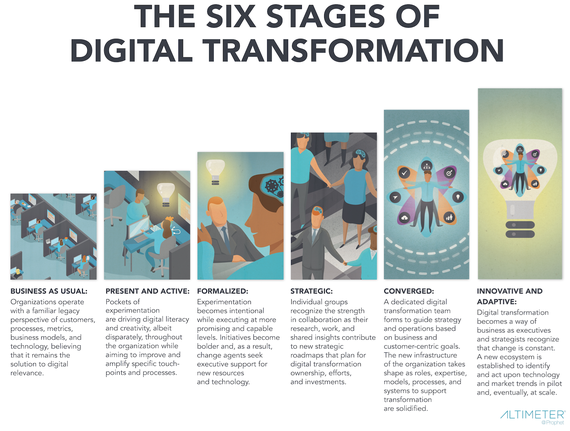by: Vala Afshar, The Huffington Post
Definition: Digital Transformation
The realignment of, or new investment in technology, business models, and processes to drive new value for customers and employees to effectively compete in an ever-changing digital economy. — Brian Solis, Altimeter Group
Brian Solis is principle analyst at Altimeter, a Prophet company. Solis is a digital analyst, anthropologist, and futurist. Solis studies the effects of disruptive technology on business and society. He is an award-winning author and avid keynote speaker who is globally recognized as one of the most prominent thought leaders in digital transformation and innovation.
Solis’ definition of digital transformation noted above is from Altimeter Group’s first maturity model for digital transformation, co-authored by Jaimy Szymanski, and in his new report, “The Race Against Digital Darwinism: Six Stages of Digital Transformation,” and it differs from other technology-first approaches.
Solis notes that although digital transformation is one of the most important trends in business, shaping how companies work, market and innovate. Solis identifies the six stages of digital transformation and a maturity model that was developed using extensive collaboration with some of the world’s leading brands.
- Business as Usual: Organizations operate with a familiar legacy perspective of customers, processes, metrics, business models, and technology, believing that it remains the solution to digital relevance.
- Present and Active: Pockets of experimentation are driving digital literacy and creativity, albeit disparately, throughout the organization while aiming to improve and amplify specific touchpoints and processes.
- Formalized: Experimentation becomes intentional while executing at more promising and capable levels. Initiatives become bolder, and, as a result, change agents seek executive support for new resources and technology.
- Strategic: Individual groups recognize the strength in collaboration as their research, work, and shared insights contribute to new strategic roadmaps that plan for digital transformation ownership, efforts, and investments.
- Converged: A dedicated digital transformation team forms to guide strategy and operations based on business and customer- centric goals. The new infrastructure of the organization takes shape as roles, expertise, models, processes, and systems to support transformation are solidified.
- Innovative and Adaptive: Digital transformation becomes a way of business as executives and strategists recognize that change is constant. A new ecosystem is established to identify and act upon technology and market trends in pilot and, eventually, at scale.
 Figure 1: The 6 Stages of Digital Business Transformation
Figure 1: The 6 Stages of Digital Business Transformation
Collectively, these phases serve as a digital maturity blueprint to guide purposeful and advantageous digital transformation. Our research of digital transformation is centered on the digital customer experience (DCX) and thus reflects one of many paths toward change. We found that DCX was an important catalyst in driving the evolution of business, in addition to technology and other market factors. — Brian Solis.
The research emphasizes that digital maturity requires multi-disciplinary involvement, including:
- Governance and leadership – an infrastructure that is driven by leadership philosophies that determine the fate of the business evolution.
- People and operations – who is involved Who is involved in Digital Transformation (DT), the roles they play, the responsibilities and account-abilities they carry, and how a company enacts change and manages transformation, including its roles, processes, systems, and supporting models.
- Customer experience – The processes and strategies aimed at improving touch points along the entire customer journey.
- Data and anaytics – How a company tracks data, measures initiatives, extracts insights, and introduces them into the organization.
- Technology integration – Implementing technology that unites groups, functions, and processes to support a holistic CX.
- Digital literacy – ways in which expertise is introduce into the organization.
According to the research, understanding the six stage of digital transformation maturity will lead to the following business benefits:
- Customization the maturity model to inform specific roadmap development
- Peer company bench-marking
- Executive alignment and buy-in
- Bolster sense of urgency
- Future marketing trend insights
- Prioritize digital transformation initiatives
- Set a new vision, course, and platform for leadership
- Develop new models, processes, and a purpose for technology and the future of work
“Though the maturity model is presented in a linear format, research shows that companies may span multiple stages at once depending on their goals, resources, and overlapping initiatives,” said Solis
By following this model, all aspects of business evolve, including management perspectives, roles and responsibilities, operations, work, and, ultimately, culture.
The model also helps executives:
- More effectively compete against existing and emerging competitors.
- Accelerate “go-to-market” initiatives in ways that are more relevant and rewarding.
- Evolve business mindsets, models, and operations to outpace competitors.
- Develop innovative products and services that stave off disruption.
- Deliver meaningful and valuable customer (and employee) experiences.
The Altimeter research includes several company case studies to further valid the model and the six stage definitions of digital transformation. The Slideshare presentation produced by Jim MacLeod, one of the top digital and creative visual marketers, is a high level summary of the six stages of digital transformation with key takeaways.


Leave a Reply